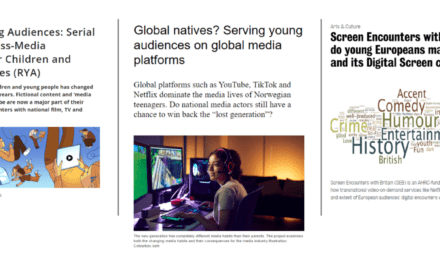The weeks surrounding the launch of the second season of the STARZ drama series Outlander – broadcast in the US on 9 April and released to Amazon Prime UK the day after – saw a spate of online journalism and fans swooning over the images released of Claire Randall/Fraser (Caitriona Balfe) and Jamie Fraser (Sam Heughan) dressed in extravagant period costumes. The burgeoning interest that viewers have shown in the series’ costumes seems unprecedented even when compared to the success of ITV’s Downton Abbey. In the Season 2 premiere, however, we see Claire’s husband Frank Randall (Tobias Menzies) burn one of those costumes. Though left largely unquestioned by viewers and critics, this seems to me a rather peculiar way to introduce a new season full of period designs screaming to be admired.
My question is: can we talk about the burning of the dress?
To recap: Outlander is based on a book series by Diana Gabaldon (1999-2014) and centres on the British former army nurse Claire as she accidentally travels back in time from 1945 to 1743 in Scotland. Claire’s initial quest to return home to her husband Frank gets complicated when she is married off to and falls in love with the Scottish Jamie in the midst of a conflict between the Redcoats and Highlanders. The couple are manipulated and raped repeatedly by Frank’s cruel ancestor Jack Randall (also Tobias Menzies), whose character continues to haunt them. The series’ costuming, designed by Terry Dresbach and Glenne Campbell, shows a varied yet stylistically consistent range of fabrics and patterns from the 1940s and 1740s respectively.
After the unanticipated success of Season 1, the series’ costumes and accessories gained major attention on social media platforms such as Etsy, Twitter, Facebook, Pinterest and Tumblr. There is a whole community on online marketplace Etsy invested in the crafting and trading of jewellery, woollen capes, tartan shawls, knitted scarfs and elbow-length mitts inspired by the series. On Twitter, not only the programme but also its costume designer Terry Dresbach and her Outlander Costume account enjoy an active following. Pinterest holds a wide variety of images and stories related to Outlander, including how-to manuals for making clothes and accessories. The large number of Outlander related blogs on Tumblr subscribes to this trend. The designs for the series have sparked a re-appropriation of “forgotten” textiles, patterns, accessories and garments.
Around the release of Season 2, Dresbach has been subjected to many “exclusive” interviews (for example here, here and here), reporting days with five hours of interviews and that is aside from the volume of questions she answers on Twitter. Dresbach also reports extensively on the design process on her blog. Prior to broadcast, STARZ had a selection of costumes showcased at Saks Fifth Avenue, linking the period costumes to contemporary fashion.
Style bloggers Tom and Lorenzo have published a semiotic breakdown of the costume designs and colour motifs in the Season 2 premiere and will continue to analyse the rest of the season, which is set mostly in eighteenth-century Paris and features abundant Versailles glamour. Surprisingly, however, although they do go into depth in pinning down the meanings of the colours and textiles, Tom and Lorenzo fail to mention that Claire’s Scottish time travel dress ends up going up in flames.
I would suggest that the attention that the costumes have received has as much to do with the costume designer’s work as with the way these garments are brought into focus by HD image technologies, framing choices and camera movements. Outlander frequently has the camera slowly glide over a costumed body, fetishizing the details of dress. Take, for example, ‘The Wedding’ (S1E7), which includes the most discussed sex scene (in which, after hours of hesitation, Jamie and Claire consummate their marriage) and the most discussed costume of the season, Claire’s wedding dress. In the wedding night scene, extreme close-ups enhance the feel of intimacy by focusing on the laces, ruffles and textures of Jamie and Claire’s underwear. The close imaging of the effort required to get undressed from eighteenth-century underwear intensifies the thrill of exposure. When Claire is liberated from her tight-laced stay, the couple first truly dare touch each other.


In a flashback to the wedding, Claire’s dress is displayed in slow-motion whilst Jamie narrates ‘it was as if I stepped outside on a cloudy day, and suddenly the sun came out’. A beam of light illuminates Claire. A close-up shot lingers on Claire’s torso in the dress, emphasising its woven texture, ruffled sleeve fabrics, tight bodice and silver embroidery. The next shot glides up along her back from the bottom back part of the wide pleated skirts, then switches to a frontal shot of Claire in her lavish bodice. After showing Jamie’s admiration, it cuts back to Claire where a crane shot slowly glides down the dress’ wide skirts, exquisite textiles and shiny adornments. Using slow-motion and close-up shots, this sequence tenderly frames the dress in HD clarity for our visual pleasure.
So how does this admiration of period costume by both the audience and the series’ imaging relate to the decision to have Frank burn such a dress in Season 2? What does this say about television’s relation to the past?
As Frank first lays eyes on the Scottish eighteenth-century clothes that Claire brought with her upon her return to the 1940s, his look is estranged and astonished, and as he studies the bodice in the window light we can see the contrast between the rough texture of clothing from a past era and the smooth surface of Frank’s modern suit. The next scene makes clear that Frank has had the clothing examined to have its authenticity and value confirmed. Frank sniffs Claire’s underdress, perhaps as a test of authenticity, but also to confirm how he is both happy she returned and intrigued by the circumstances of her disappearance.
Allegedly to “leave the past behind”, from Claire’s view from a window we see Frank laying the eighteenth-century shift on a fireplace outside, looking up to her as the dress goes up in flames.

This scene captures the way Outlander shows both the celebration and destruction of beauty. There are parts of history that we would rather burn to stop them from haunting us, which in Outlander is primarily the case with the sexual assault narrative threading through Season 1. Extreme close-ups of Claire being undressed from her beautiful clothing are also central to the scene in which she is raped by Jack Randall in ‘Both Sides Now’ (S1E8), but here the focus on the costume emphasises the lack of female agency inscribed in eighteenth-century dress. The close framing of costume can evoke visual pleasure and highlight the restriction imposed on the wearer, showing us the “barbarism” of the time represented.
The burning of the dress reflects Outlander’s ambivalence in (ad)dressing the past, as it both fetishizes and destroys the beauty of this representation of women’s lives in the eighteenth century. Of course this is of highly fictional nature and consciously anachronistic – as also the 1940s Dior style traits of time-traveller Claire’s dresses make clear – but it does speak to wider issues of how “nostalgic” television deals with the past (see, for instance, Holdsworth 2011; Niemeyer & Wentz 2014; Pierson 2014). Outlander presents (in a sometimes clever, sometimes banal or oddly coarse way) a world that is entrancing but also violent and vulgar, which can make us question our obsession with these images and styles from the past.
Josette Wolthuis is a PhD candidate in Film and Television Studies at the University of Warwick. Her research explores the functions of costume and fashion on television. She is a member of the Midlands Television Research Group and the Centre for Television History, Heritage and Memory Research.





